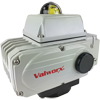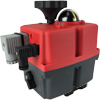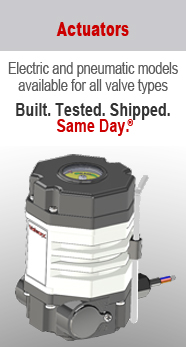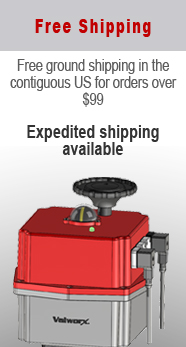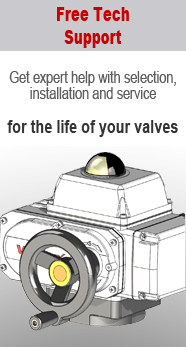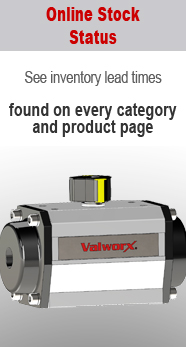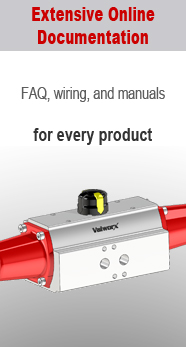Electric Actuators & Accessories
Learn About Electric Valve Actuators & Accessories
Electric actuators are used to remotely operate ball, butterfly, gate and globe valves. They do not require an air supply like pneumatic actuators, so they are well-suited to field applications where manual operation is not feasible and long runs of pneumatic piping are impractical.
Electric actuators are either quarter turn or multi-turn. Quarter turn units are used for ball valves and butterfly valves, where the valve is completely opened (or closed) via a 90° rotation. Multi-turn actuators are typically used to drive a jack screw, thus providing linear motion for gate, globe and diaphragm valves.
At Valworx we specialize in ball and butterfly valves, so we'll focus on quarter-turn actuators for this discussion.
The heart of any electric actuator is, of course, an electric motor. To minimize motor size and current draw, motors are commonly connected to a gear drive. Manufacturers typically use different gear drives with the same motor to offer actuators with different torque ranges. Higher torque results in a tradeoff of higher cycle time, as the gear ratio is also higher.
The gear drive is connected to an output drive, and it is this output drive that is connected to the valve. We'll discuss the output drive more in the Mounting section below.
Other components include a motor start capacitor to provide supplemental in-rush current during motor start and PC boards to condition and distribute power as well as provide control functions.
These components are housed in a weatherproof enclosure which can be made from polyamide, powder-coated aluminum or steel or, for highly corrosive environments, stainless steel.

Valworx quarter turn actuators use a standard bolt pattern (ISO5211) to connect to the valve. The ISO5211 standard specifies the stem size, bolt size and bolt radius. This widely accepted standard allows valves and actuators to be mounted regardless of manufacturer. Some manufacturers also have brand-specific mounting patterns. All Valworx valves and actuators utilize the ISO5211 mounting standard.
A customer-supplied external relay energizes the motor circuit to power the actuator closed. An external reversing switch reverses current, and the motor runs in the opposite direction to open the valve. The motor is shut off when an internal limit switch is opened, cutting power to the motor.
Wiring for electric actuators can be as simple as a three-prong DIN plug or more than a dozen individual connections. Our multi-voltage actuators are wired using DIN plugs. Wiring for single voltage actuators is actuator-specific. Some examples are shown here. All Valworx actuators are shipped with installation and Operation Manuals (IOM) to ensure proper wiring.



Torque: Electric actuator torques can vary from a few Newton-meters (Nm) to several thousand. Torque for Valworx actuators range from 18- 600Nm. All Valworx assemblies are pre-engineered to ensure the actuator is sized for the proper torque for the corresponding valve, including a nominal safety factor.
Cycle Time: Cycle times (ie the time it takes to fully open the valve from the closed position or vice-versa) for electric actuators are typically longer than for pneumatic actuators. Electric actuator cycle times range from ~15 sec to 3 or 4 minutes for larger, higher torque actuators. In contrast, the cycle time for pneumatic actuators is usually around one second.
Duty Cycle: Duty cycle is defined as the energized time (energized + non-energized time). More practically, for On/Off applications duty cycle is (time to open + time to close) divided by (time to open + time to close + rest time). For instance, if it takes 20 seconds to open and 30 seconds to close, with 50 seconds of rest in between, the duty cycle would be (20 + 30)/(20 + 30 + 50) = 50%.
All electric actuators come with a duty cycle rating. The more robust actuators have a duty cycle rating of 70% or better.
Over Torque & Thermal Protection: A blocked or jammed valve can stall the motor and cause damage. Many electric actuators have built-in protections against this. Our 5610/5615/5616 series actuators have internal circuitry that sense an over torque condition and shut down the motor. Our 5618/5818 series has a thermal protection circuit to prevent motor overheating.
Limit Switches: Quarter turn electric actuator stroke is controlled by cams striking internal limit switches. When the closed position is reached, the switch lever rides up on the cam lobe and breaks the circuit, thereby shutting off the motor. Current is applied to the "open" circuit, and the motor runs in the opposite rotation to open the valve until a corresponding limit switch shuts it off. The open and close positions can be adjusted by changing the cam position.
In addition, some electric actuators have position confirmation switches. These send a signal to an external controller (such as a PLC) to indicate when the valve is fully opened or closed. Valworx electric actuators include position confirmation switches as standard.
Failsafe: Upon loss of electric power failsafe actuators can be set to fail-open or fail-close. This is accomplished by either a battery backup or a spring return mechanism. Battery backup actuators utilize a battery to power the actuator to the failsafe position. The battery is charged (and re-charged) by the same line power that runs the actuator.
Spring return actuators use a compressed spring to return to the failsafe position. Under normal operation the actuator compresses an internal spring as the valve is actuated. While not having to worry about batteries is an advantage, the motor is working against the compressed spring. This greatly reduces the torque available for actuation.
Valworx 5610/5615/5616 series actuators offer a battery safe return (BSR) kit as an option.
Positioning: In addition to On/Off operation, electric actuators can modulate, or throttle, the valve. This is accomplished by either a 4- 20mA or 0- 10VDC analog control signal. An internal servo operates the motor until the input and feedback signals match. Valworx actuators also provide an output confirmation signal.
We offer complete modulating units for our 5618/5818 series and as a factory-installed option on our 5610/5615/5616 series actuators.
Multi-Voltage: Some electric actuators have a voltage auto-sensing capability that enables them to operate on a variety of input voltages. Valworx 5610/5616 series actuators operate on 24- 240 VDC or VAC.
Network Communications In addition to supplying a confirmation signal, some actuators can be equipped to communicate on a network or databus such as Modbus or Profibus. Valworx 5610 series actuators offer Modbus integration as an option.
Manual Override: Sometimes it is necessary to operate or adjust the valve manually. This is done by a manual override such as a hand wheel or knob.
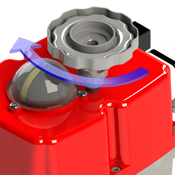
Position Indicator Position indicators allow the operator to view the valve position at a glance. Domed indicators are generally preferred over dial ones as they can be seen without having to stand over the actuator.
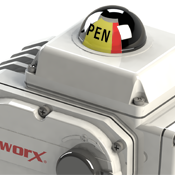
Thermostatic Heater: Internal moisture can condense and damage electrical components. To prevent this, some actuators come equipped with a small thermostatic heater. Power should be applied even if the actuator is not in use so the heater remains operational. All Valworx electric actuators come with anti-condensation heaters as standard.
Explosion Proof: In some applications flammable gases may be present. Electric actuators have the potential to arc or spark, and for this reason it may be necessary to use an explosion proof actuator. ExP actuators are designed to contain an internal explosion, thereby preventing a larger explosion in the general environment.
Explosion proof actuators are certified for specific environments and temperatures. Valworx 5818 series actuators are certified for use in Class I Div I and the corresponding ATEX and IECEx applications.
Electric actuated valves are used in virtually every industry that requires automated fluid control, including irrigation and wastewater, oil and gas, chemical, food and beverage and general industrial applications. Their versatility, ease of installation and reliability make them an excellent choice for automated fluid control applications.

